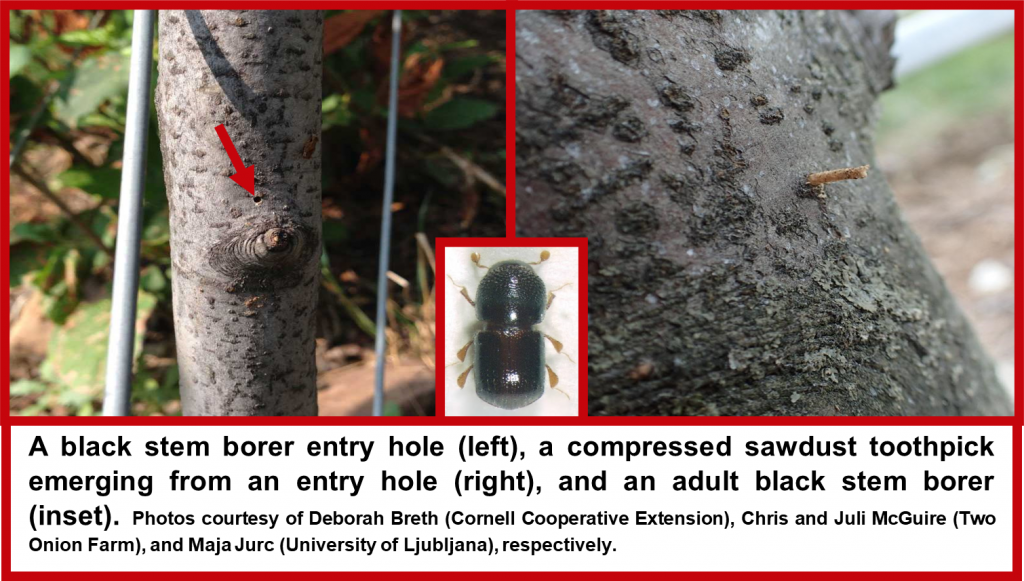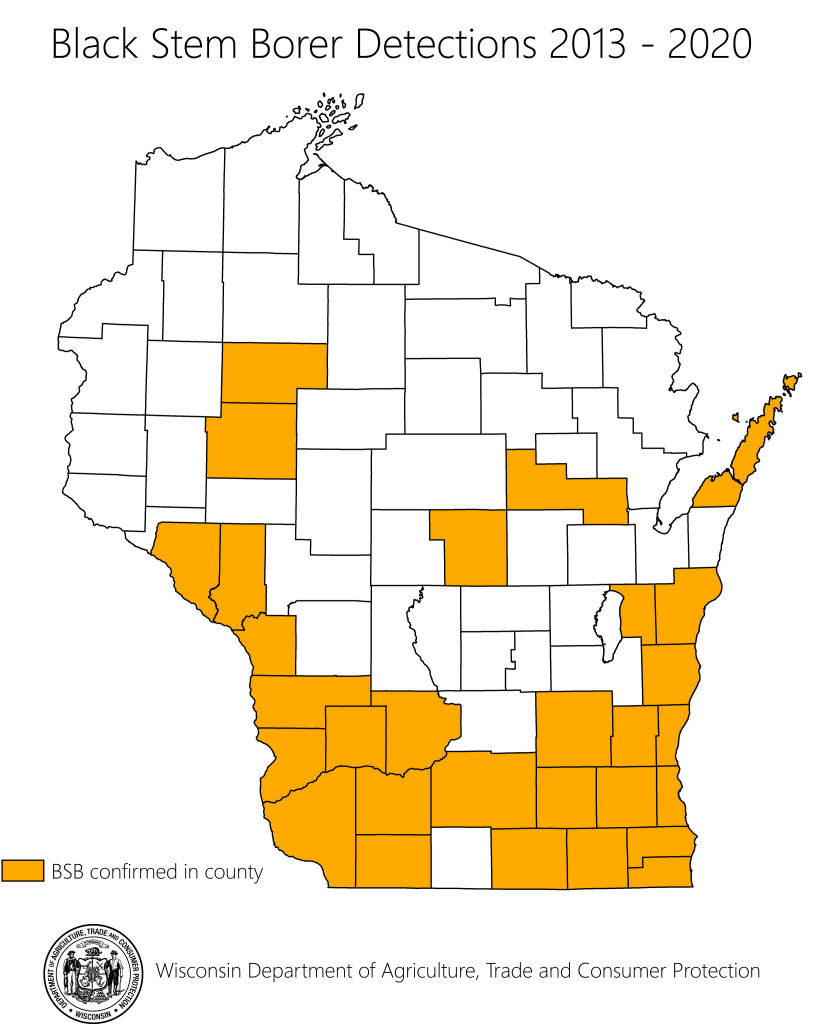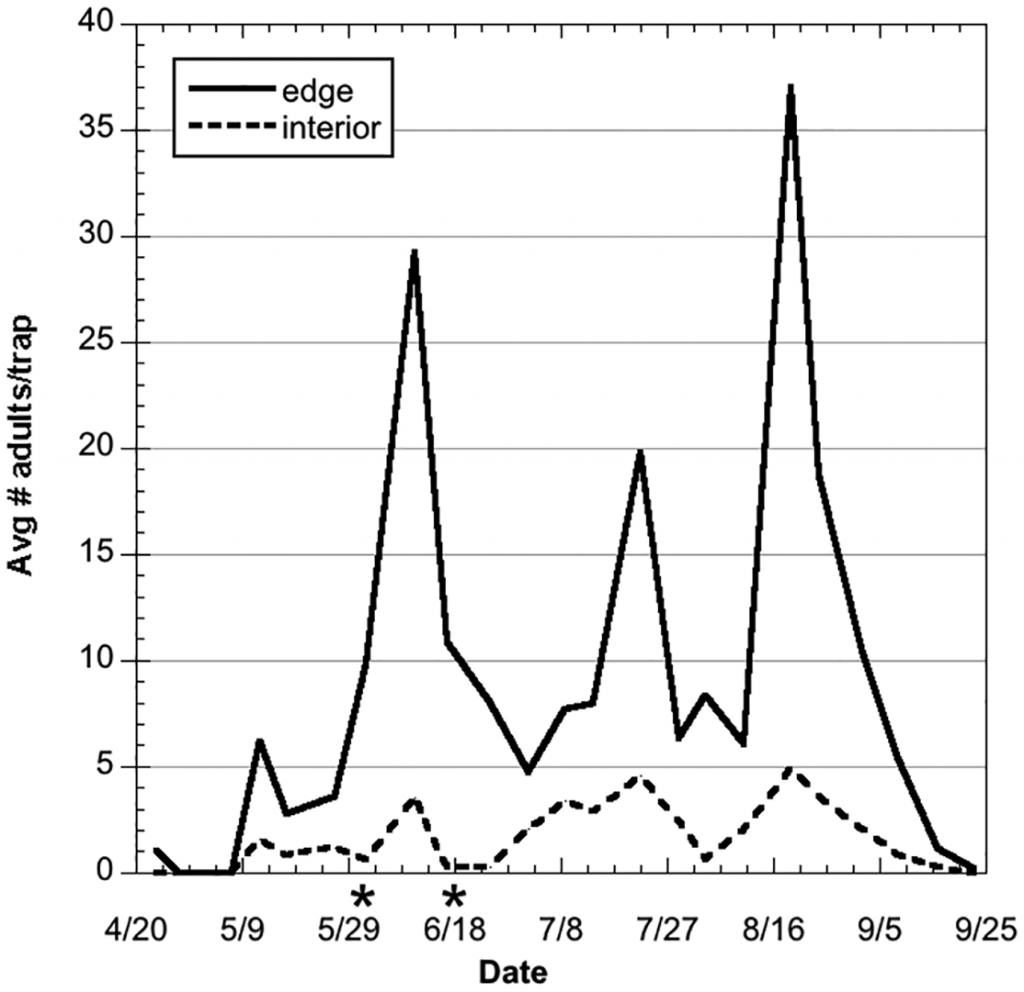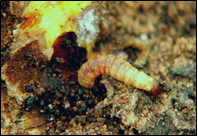Black Stem Borer and Dogwood Borer Management Updates
Black stem borer (BSB)
BSB, Xylosandrus germanus, also known as the alnus ambrosia beetle, is an invasive beetle from Asia accidentally introduced into central Europe and North America.
Serious pest of nursery and landscape trees, but has been reported as a pest of fruit crops and more recently on fruit trees, particularly in New York and Michigan.
Appearance: Adult BSBs are small insects that are between 1/8 and 1/16 inches in length. Reddish brown to nearly black in color and cylindrical. Only females are known to fly. Larvae are small, white, legless grubs.

Life Cycle: BSB overwinters as adults (primarily females) in host trees. Overwintering adults are usually found in wooded areas, and move to other trees more than 330 feet away to colonize new trees in the spring. Overwintering adults become active in late April to early May following one to two consecutive days where temperatures are 68°F or higher. BSB prefers trees that are <3” in diameter where they bore holes (~ 1/16” in diameter) in the trunks, typically in lower 2-3’. Females create a network of galleries under bark where they lay eggs and larvae develop. Females lay one egg per day and can deposit up to 18 eggs. After eggs hatch, larvae develop through 3 instars, with ~ 30 days from egg to adult. BSB adults and larvae do not feed on plant tissue, but on a symbiotic fungus (Ambrosiella hartigii) that females carry in internal pouches (called mycangia). Females disseminate the fungus in their galleries where it grows and spreads providing a food source for the beetles. New adults typically emerge in July and the second generation of adults (which overwinters) typically begins to appear around the end of August and into September.

Distribution
Since 2013, BSB has been detected in 29 counties in Wisconsin
Prior to 2019, only found at lumberyards and wood waste disposal sites. In June 2019, confirmed in a commercial apple orchard in Lafayette County.
Symptoms and Effects:
- Wilting and dieback typically first noticeable symptoms of a BSB infestation.
- Symptoms are result of defense responses from tree to presence of BSB.
- General tree decline and eventual death often follow.
- Small holes in the lower trunks of infested trees.
- Columns of compressed sawdust (“toothpicks”) often emerge from these holes.
- Dry, dark-colored, blistery bark and oozing sap are other typical symptoms.
- BSB activity may occur in association with plant diseases such as fire blight and other canker diseases (e.g., Fusarium canker). Unclear if stress from diseases makes trees more attractive to BSB, if BSB is spreading disease-causing organisms, or both.
- Trees stressed from flooding, frost injury, and drought particularly attractive to BSB. Stressed trees produce several types of volatile chemicals (including ethanol) that attract BSB.

DATCP/IPM Institute monitoring: In 2020, total number of BSBs at orchards in 12 counties ranged from 0 – 1,323 with average of 364 per orchard. Earliest trap catch in WI orchards in 2021 on 4/27/21 and reports of <1” diameter apple trees dying in Dane (likely stressed trees from disease in drought in 2020). Highest number is 483 beetles as of 5/6/21 at orchard edge in Dane.

Scouting: Examine trees for typical symptoms esp. around woodlot edges. Use ethanol-baited traps to monitor flight activity of adult females in spring. Traps: 1-2L plastic bottles, cut 2-4 windows from the sides. Cap bottles and hang upside down at 20” height. Concentrate traps around sensitive trees (particularly orchard trees) near wooded areas. Bait traps with one cup of vodka, ¼ cup ethanol-based unscented hand sanitizer, or hang ready-made ethanol lure (e.g., Standard Release ethanol lures, AgBio, Inc., Westminster, co) inside trap and fill bottom of the trap with a small amount of a drowning solution (e.g., soapy water or antifreeze). Check traps weekly (daily with hand sanitizer). Identification of BSB requires use of a microscope and proper training. If you suspect BSB, send a specimen or good digital photo to the UW-Madison Insect Diagnostic Lab (https://insectlab.russell.wisc.edu/).
DD model: To monitor populations using degree day models, it is recommended to place traps in early April. In NY, the first adults usually caught in ethanol-baited traps around 145+/- 41DD with a base of 50F. Another way to look at this is to monitor max temperatures for at least 60°F for 1–2d as this would coincide with the beginning of flight activity. This would correspond to a mean occurrence of first capture in ethanol-baited traps at around 76 DD (base 10 C) from January 1, which would occur generally between last week in April and first week in May in NY.
Control:
- Remove and burn any infested trees to prevent infestations to surrounding trees.
- Minimize stresses on trees to make them less attractive to BSB. Protect young trees near woodlot edges
- NY recommends a Lorsban trunk spray prebloom, followed with a trunk spray (or 2 if needed) in June with pyrethroids (e.g. Warrior or Danitol).
- For organic production preventing stress on trees and removing infested trees.
Dogwood borer (DWB) update

DWB lay eggs under the bark at burr knots or damaged areas on apple or other host trees. The larvae crawl under the bark and feed on the living tissue of the tree, causing a loss of vigor and eventual death. Burr knots are often found on trees with dwarfing rootstocks, including Malling and Malling-Merton (MM111 only of these rootstocks to show indication of resistance to DWB). Damaged areas can be caused by pruning, hitting the trunk with a mower or other farm equipment, or places where branches are rubbing against each other.

Identification and Damage Symptoms. The adult DWB flies during the day and looks similar to a wasp, although it is in fact a moth. Larvae are light pink maggot-looking caterpillars with a dark brown head, developing entirely within the tree. One generation per year, but larval development spans from late June through following spring, overwintering as a larva inside the tree. Adults are active from May through September. Damage generally includes a loss of tree vigor, occasionally culminating in death after continuous infestation for several years. Dogwood borer feeding sites often have reddish frass on the burr knot or other damage point.
Status in Wisconsin. Peter Werts at IPM Institute shared some of their monitoring data in Walworth county. Populations have increased over the last 4 years, averaging ~1 moth per week in 2017 to 100 moths on 6/23 and 8/4 in 2020. As numbers have drastically increased at least in some orchards, monitoring and possibly management is recommended.
Monitoring
Monitoring can be done using pheromone-baited traps placed at ~head-height (4’) in the trees.
Control
Cultural control includes painting the lower trunk with white latex before egglaying occurs which can discourage dogwood borer females from ovipositing. Consider which rootstocks are most likely to cause burr knots. Allowing sunlight and air-circulation on the graft union can help minimize the risk of burr knot development. Planting with the graft union close enough to the ground to allow existing burr knots to form roots can reduce infestation levels.
Mating Disruption (Isomate®) can be applied in spring before end of May. Registered by Pacific biocontrol available in Wisconsin. Unlike traditional mating disruption pheromones, it is repellent to males seeking out females, pushing them out of the orchard. Requires 100-200 dispensers per acre. Recommended 150 dispensers for 1st year implementation or high populations. Placed at chest height on lateral branches.
Chemical control options include organophosphate (e.g., Lorsban), pyrethroids (e.g, Warrior), and neonicotinoids (e.g, Assail). Lorsban as a trunk spray applied in the spring or fall provides best control while Assail used as trunk spray requires 2 applications, one between pink and mid-June and again before August.
In organic production, cultural control strategies outlined above are recommended.
This article was posted in Insects and tagged black stem borer, Christelle Guédot, dogwood borer, insects.
